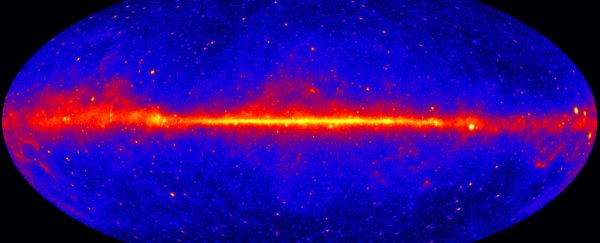Something is glowing at the heart of the Milky Way - there's more diffuse gamma radiation than can be explained by what we can directly observe. It's called the Galactic Center GeV Excess (GCE), and astronomers have been trying to explain it for years.
One idea was that the glow is produced by the annihilation of dark matter. Then, it began to look like the culprit was actually millisecond pulsars that have somehow eluded detection. Now, a new paper could bring dark matter back into the game.
Using simulated data, theoretical astrophysicists Rebecca Leane and Tracy Slatyer of MIT have found a flaw in the millisecond pulsar analyses.
"We discover striking behaviour consistent with a mismodelling effect in the real Fermi data, finding that large artificial injected dark matter signals are completely misattributed to point sources [i.e., millisecond pulsars]," they wrote in their paper.
It's yet to be peer-reviewed, but if their calculations pass muster, the paper could blow the GCE debate wide open again.
It first arose about 10 years ago, when physicists noticed an excess of gamma radiation in the data collected by the Fermi Gamma Ray Space Telescope.
They thought that the culprit could be long-hypothesised, never observed dark matter annihilation: Even though we can't detect dark matter directly, it could be producing radiation we can see.
If types of dark matter particles called Weakly Interacting Massive Particles, or WIMPs, were to collide with each other - like the collisions generated by particle accelerators - they would annihilate each other, exploding in a shower of other particles, including gamma-ray photons.
This should produce a pretty recognisable signal - an even distribution of these photons. But two separate statistical analyses published in 2016, one of which was co-authored by Slatyer, found the photons distributed in clumps instead.
The source, they concluded, was more likely a population of millisecond pulsars, neutron stars that rotate up to 1,000 times per second. They were too faint to be detected individually, instead producing a diffuse glow.
So, Slatyer and Leane mathematically simulated the Milky Way, adding in a few more pulsars as well as dark matter annihilation. They found that, even when they added dark matter as the source of some of the GCE, an analysis using the same methods from 2016 still misidentified the origin as millisecond pulsars and gamma radiation from the Fermi bubbles blown by the supermassive black hole in the galactic core.
Now, this doesn't mean that the dark matter is there. It just shows that the analytical methods used to locate the source of the GCE in 2016 are likely unreliable. That there's something scientists don't understand fully.
"Something about our understanding of the gamma rays is missing at this stage," Leane told Quanta. "It's possible to hide a dark matter signal, if it were really there."
Two other recent preprint papers seem to be adding support, too. They found larger than expected amounts of antiprotons in spectrometer data, another possible by-product of dark matter annihilation.
At the moment, though, the results are unconfirmed by the peer-review community, so the jury remains well and truly out, and millisecond pulsars remain firmly on the table.
But the game ain't over for dark matter yet, either.
The paper has been published on arXiv.
